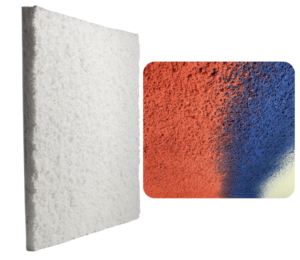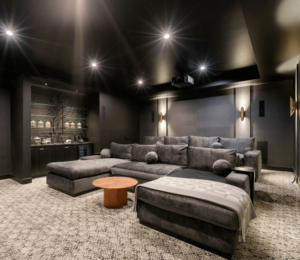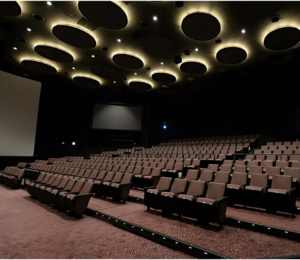In today’s noisy world, controlling unwanted sound is crucial—whether in offices, homes, or commercial spaces. Gitco provides advanced soundproofing and sound masking solutions tailored to meet the unique acoustic needs of Saudi Arabia’s dynamic environments. But what’s the difference between these two approaches, and which one is right for your project?
This guide explores:
✔ What is soundproofing?
✔ What is sound masking?
✔ Key applications for each solution
✔ Gitco’s industry-leading products
Soundproofing: Blocking Noise at the Source
Gitco’s Soundproofing Solutions
| Solution | Best For | Key Benefits |
|---|---|---|
| Acoustic Panels | Recording studios, home theaters | Absorbs mid/high frequencies, reduces echo |
| Sound Barriers | Offices, industrial plants | Blocks airborne noise (STC 50+) |
| Soundproof Curtains | Temporary partitions, windows | Heavy-duty mass-loaded vinyl for noise reduction |
| Decoupling Systems | Floating floors, resilient channels | Prevents structural noise transfer |
Where is Soundproofing Needed?
✔ Recording Studios – Prevent external noise interference
✔ Home Theaters – Isolate loud audio from living spaces
✔ Offices & Meeting Rooms – Ensure speech privacy
✔ Industrial Facilities – Reduce machinery noise pollution
Sound Masking: Enhancing Privacy Through Controlled Noise
Gitco’s Sound Masking Solutions
| Solution | Best For | Key Benefits |
|---|---|---|
| Ceiling-Mounted Emitters | Open-plan offices | Discreet, uniform sound coverage |
| Desktop Sound Maskers | Private offices | Adjustable volume and frequency |
| HVAC-Integrated Systems | Corporate buildings | Seamless noise blending with ventilation |
Where is Sound Masking Needed?
✔ Corporate Offices – Reduce eavesdropping in open spaces
✔ Healthcare Facilities – Maintain patient confidentiality
✔ Call Centers – Improve focus by masking chatter
✔ Hotels & Resorts – Enhance guest privacy
Soundproofing vs. Sound Masking: Which One Do You Need?
| Factor | Soundproofing | Sound Masking |
|---|---|---|
| Primary Goal | Blocks noise | Covers noise |
| Best For | Studios, theaters, industrial sites | Offices, hospitals, coworking spaces |
| Installation | Requires structural modifications | Minimal installation (often wireless) |
| Cost | Higher upfront (materials + labor) | Lower cost, easier to implement |
Pro Tip: Many spaces benefit from both solutions—soundproofing to block external noise and masking to improve internal acoustics.
Why Choose Gitco for Acoustic Solutions in Saudi Arabia?
✅ Local Expertise – Custom solutions for KSA’s climate and architecture
✅ High-Performance Materials – Tested for durability and efficiency
✅ End-to-End Service – From consultation to installation
✅ Proven Results – Trusted by VOX Cinemas, KAPSARC, and major Saudi corporations
Soundproofing vs. Sound Masking – Frequently Asked Questions
Understanding how to manage sound in your space is crucial for comfort and productivity. Two common approaches are soundproofing and sound masking. While they both address noise, they work in fundamentally different ways. Let’s explore the key differences and help you determine which solution, or combination, is right for your needs.
Frequently Asked Questions:
- What is soundproofing?
- Soundproofing is the technique of physically blocking or reducing the transmission of sound from one area to another. It aims to prevent sound waves from passing through walls, ceilings, floors, doors, and windows.
- What is sound masking?
- Sound masking is the process of adding a low-level, unobtrusive background sound to an environment to reduce the intelligibility of speech and make other distracting noises less noticeable. It doesn’t eliminate the sound but covers it up.
- What is the primary goal of soundproofing?
- The primary goal of soundproofing is to create a quiet environment by preventing sound from entering or leaving a space.
- What is the main objective of sound masking?
- The main objective of sound masking is to enhance speech privacy and reduce the distraction caused by unwanted noises within a space.
- How does soundproofing work?
- Soundproofing works by using dense materials to block sound waves, decoupling structures to prevent vibration transmission, and sealing gaps to stop sound leaks.
- How does sound masking work?
- Sound masking works by introducing a specifically engineered sound, often compared to airflow, through strategically placed speakers. This sound covers up distracting noises, making them less intelligible.
- What types of materials are used for soundproofing?
- Common soundproofing materials include mass-loaded vinyl (MLV), acoustic mineral wool, soundproof drywall, acoustic membranes, resilient channels, and acoustic sealants.
- What kind of sound is used for sound masking?
- Modern sound masking systems use engineered sounds specifically tuned to the frequencies of human speech, making them more effective and less intrusive than generic white noise.
- Where is soundproofing typically used?
- Soundproofing is ideal for recording studios, home theaters, confidential meeting rooms, and residential spaces where a high degree of sound isolation is required.
- In what environments is sound masking most effective?
- Sound masking is particularly effective in open-plan offices, healthcare facilities, libraries, call centers, and any space where speech privacy and reduced distractions are desired without complete silence.
- Is soundproofing expensive?
- Soundproofing can be a significant investment as it often involves structural modifications and specialized materials.
- Is sound masking a cost-effective solution?
- Sound masking is generally more affordable and less disruptive to install in existing spaces compared to extensive soundproofing.
- Does soundproofing improve speech privacy?
- Yes, effective soundproofing can significantly improve speech privacy by preventing conversations from being overheard.
- How does sound masking enhance speech privacy?
- Sound masking makes conversations less intelligible to unintended listeners by raising the ambient sound level in a way that covers up speech frequencies.
- Can you combine soundproofing and sound masking?
- Yes, combining both approaches can be the most effective solution in many modern workplaces. Soundproofing can block external noise, while sound masking enhances internal speech privacy and reduces distractions.
- Does sound masking reduce the overall noise level in a room?
- No, sound masking adds sound to the environment. However, it reduces the perception of noise by making distracting sounds less noticeable.
- Is sound masking the same as white noise?
- No, modern sound masking is different from white noise. It’s specifically engineered to match human speech frequencies and is designed to be less irritating and more effective.
- What are the benefits of sound masking in an office environment?
- Benefits include enhanced speech privacy, reduced distractions, increased productivity, and improved acoustic comfort.
- When should I choose soundproofing over sound masking?
- Choose soundproofing when you need to completely block sound transmission and create a virtually soundless environment.
- When is sound masking a better choice than soundproofing?
- Sound masking is a better choice when the goal is to improve speech privacy and reduce distractions in open or semi-open environments without the need for complete sound isolation.
Transform Your Space Today
Whether you need complete sound isolation or enhanced speech privacy, Gitco delivers bespoke acoustic solutions for every environment.



